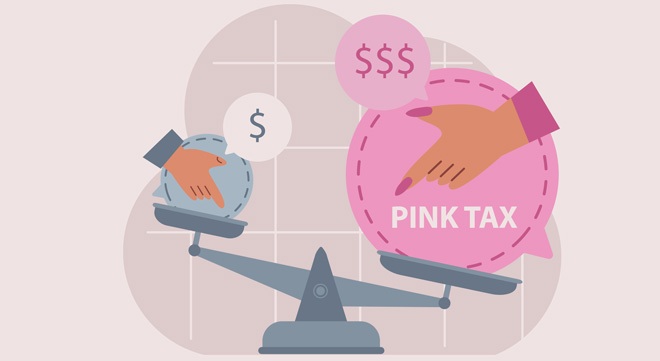Ever heard of “pink tax”? If not, you’re among 75% of the 446 participants in a recent survey by Sanlam. The survey found that 335 respondents were unaware of pink tax, with only 20% of men and 30% of women having heard of it.
Pink tax refers to the practice of pricing products and services marketed to women higher than similar items aimed at men. This phenomenon spans various categories, including personal care products, clothing, and services such as haircuts. It also extends to financial products.
Among the survey’s key findings, 22% of the total sample had noticed a difference in fees for financial products based on gender.
Twenty-four percent of women said pink tax influenced their decisions about which financial products, services, and providers to pursue. This was particularly true for car insurance, where 14% of women said pink tax was an influencing factor. Nine percent of women also believed there were disparities for general insurance, and 6% of women perceived differences in loan interest rates.
Pink tax can result in women paying significantly more over time for everyday goods and services simply because they are marketed to them, and, according to Sanlam’s recent survey, pink tax is pervasive. Fifty-three percent of female respondents said they encounter pink tax sometimes, and 19% said they see it often.
Farzana Botha, senior communications manager at Sanlam, says, most women, including herself, have personal experiences with pink tax.
“For instance, when it comes to vitamins and specialist consultations, we often seem to pay more than men, highlighting a disparity even for essential healthcare. Not to mention that women usually pay more for contraception, and continue to pay VAT for tampons, menstrual cups, and more.”
Botha says pink tax permeates most industries and has a profound impact.
“Women, who already face a gender pay gap, must allocate a larger portion of their income to higher-priced goods and services. This disparity is exacerbated by the fact that women often head households and have longer life expectancies. Consequently, pink tax contributes to a cycle of financial strain that affects not only individual women but also their families and future generations.”
She adds that pink tax is a broader, systemic issue that is often particularly harmful to women in marginalised communities, who frequently have less access to competitive shopping options and discounts.
The strain of higher-priced necessities can perpetuate cycles of poverty and inequality, impacting women’s financial well-being. The “tax” makes it even more challenging to save, invest, and build financial security for the future.
Other findings from the survey are:
- 37% of women said they noticed they paid more for a product or service because of pink tax.
- Only 24% of men said pink tax had affected their decision to purchase a product or service, compared to 54% of women.
- 52% of men versus 75% of women thought it was very unfair for companies to charge more for products and services marketed to women. Six percent of men thought it was somewhat fair.
- 78% of men versus 91% of women were in favour of regulation to prevent gender-based pricing disparities.
- 39% of the total sample were willing to pay more for a product or service to secure fair pricing for all, 37% said they might be willing, and 24% said no. Thirty-one percent of men said no compared to 17% of women.
Power to axe the tax
The survey found that 91% of women were in favour of regulation to prevent gender-based pricing disparities.
Botha says women should use their significant purchasing might to fight pink tax.
“Women wield immense power to axe the tax. MAPS data found that 58% of women make their household’s daily purchasing decisions, with particular weight when it comes to child- and medical-related products. Additionally, 65% of South Africa’s single-parent homes are headed by women. By raising awareness of pink tax and using our purchasing might to push for parity, we can and will create change.”
Twenty-one percent of women said pink tax influenced them to switch to men’s or unisex products, 9% said they did price comparisons and shopped around, and 11% avoided gender-specific products. Women were also more likely (5%) to reject products or services based on a moral stance against pink tax.
Botha underscores the positive developments surrounding awareness of the pink tax, stating, “We’re already seeing women notice pink tax and fight back through their purchasing power. We need to leverage this and talk about the tax, so everyone has a chance to choose fairness. We must share our experiences to empower others. If there’s blatant pink tax at play, we should raise awareness around it and challenge that provider. Men can be our allies in this by also calling out gender-based price differences.”
She advocates for proactive measures: “Similarly, we can actively choose to support brands and companies that promote gender-neutral pricing. Plus, we can do the work of shopping around to make price comparisons and choose the products and services that are the best value – even if these seem marketed to men.”
Highlighting the importance of financial security, Botha notes, “Women can also protect themselves through fairly-priced policies that align with their unique needs. For example, we know many single households in South Africa are headed by women. That’s where income-, disability-, and severe-illness cover could be invaluable, should you be rendered unable to earn an income.”
She stresses the value of guidance, suggesting that “it can also be helpful to have the right team on-side. For example, an intermediary who understands pink tax, and the other unique challenges women face, can help you navigate these and build wealth for yourself and your family, for the long term.”



